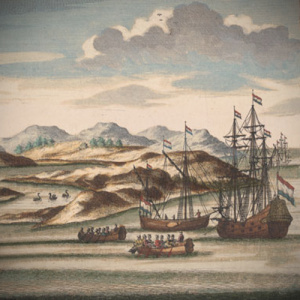Brief account of the principal events on the voyage of the frigate the Geelvink to the Southland (Australia), 20 March 1697

Introduced Roelof van Gelder
Download the full article in PDF
‘About one o’clock in the afternoon, we anchored in the roadstead of Batavia, with five fathoms depth. God be praised for a safe journey’. These lines were written by Captain Willem de Vlamingh on 20 March 1697 at the end of the log which he had kept during his expedition to the Southland (Australia). On the same day, a clerk in Batavia reported De Vlamingh’s arrival, as we can read in the following document.
This marked the final act of an expedition of three ships which had sailed eleven months earlier, in May 1696. After long deliberations, the VOC directors in the Netherlands had decided to organize this expedition. Three goals were set. In the first place, the ships had to look for a VOC ship, De Ridderschap van Holland, which had departed from Flushing in 1693. She had reached Cape Town and had continued her voyage to Batavia from there, but since then nothing had been heard of her. Although this had all happened three years before, not all hope had been abandoned of finding De Ridderschap van Holland and her crew. Maybe she had been stranded somewhere in the Indian Ocean on the shores of the islands of Amsterdam or St Paul, or on the west coast of Australia. Nevertheless, before investigating these places, De Vlamingh was ordered to sail to the Tristan da Cunha group in the South Atlantic.
All these islands and coasts had to be surveyed, described and meticulously mapped. A report was expected which would outline the commercial opportunities for the Company. Over and above this, the expedition had a scientific aspect. At the request of the Amsterdam VOC director, the scholar Nicolaas Witsen, De Vlamingh and his men were to try to capture one or more inhabitants of Australia and transport them to Batavia or even to the Netherlands. They might possibly provide useful information about the land and its culture. Witsen also urged that an artist be attached to the crew.
After well-organized preparations, De Vlamingh commenced his voyage on the frigate Geelvinck accompanied by two smaller ships, the Nijptang en Het Wezeltje. One hundred and ninety-eight man crew embarked on the ships, including the painter Victor Victorsz.
The expedition began successfully. Tristan da Cunha was reached and explored. From there the ships sailed for Cape Town, where three Asian persons were taken on board. De Vlamingh expected them to serve as translators in Australia. The islands of Amsterdam and St Paul were surveyed and after that, for almost two months, the west coast of Australia was investigated and mapped. However, although they came upon some wreckage of Dutch ships, they found no trace of De Ridderschap van Holland or her crew. From Australia the ships sailed to Batavia.
The goal of the expedition had been achieved,but only just. The lost ship was not found and, although De Vlamingh could give full reports of the geographical and physical aspects of the places he had inspected, as well as the flora, fauna and inhabitants, the directors were disappointed that he had not investigated larger areas of the Southland. De Vlamingh’s conclusion was that Australia would not in any way be useful to the Company. In this wild, dry and desolate land, no minerals were to be found and commercial relations with the inhabitants carried absolutely no prospect of any profit. After reporting extensively, De Vlamingh returned to the Netherlands. His voyage was the last VOC expedition of any importance to Australasia.
This expedition is extremely well documented. All the instructions have been preserved in the VOC archives in The Hague, the names of the crew members are all known, the logs of the three ships have survived, as well as the maps and the watercolours of Victor Victorsz. These last are kept in the Maritime Museum Rotterdam.
The whole expedition is extensively analysed in G.G. Schilder: De ontdekkingsreis van Willem Hesselsz. de Vlamingh in de jaren 1696-1697. Den Haag: Nijhoff, 1976.
Roelof van Gelder, “Brief account of the principal events on the voyage of the frigate the Geelvink to the Southland (Australia), 20 March 1697”. In: Harta Karun: Hidden Treasures on Indonesian and Asian-European History from the VOC Archives in Jakarta, document 2. Jakarta: Arsip Nasional Republik Indonesia, 2013.




